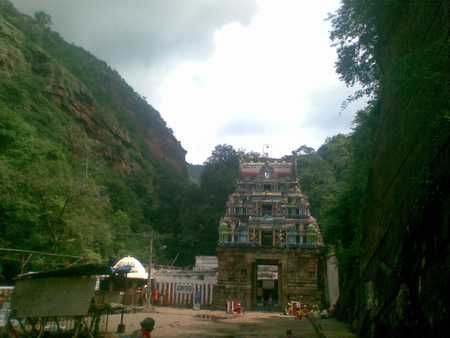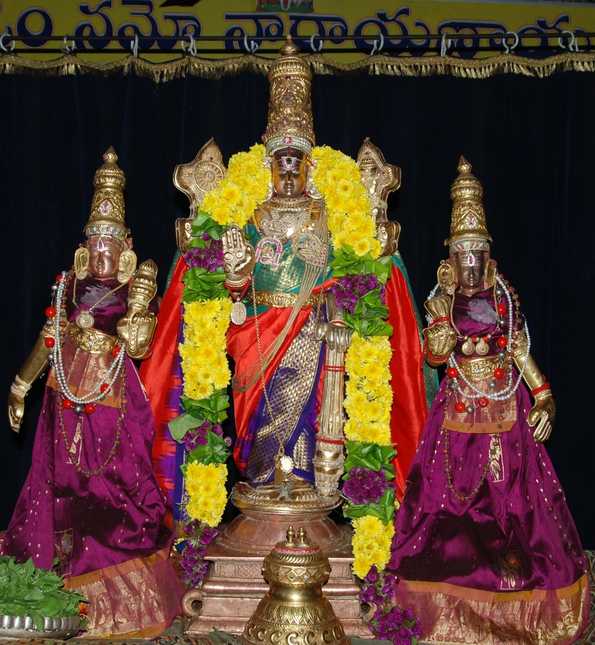Located about 110kms North West of Cuddapah amidst the dense Nalla Malai Forest of the Achalachaaya Meru mountain range is the Singavelkundram Divya Desam in Ahobilam, one of the 16 prominent Swayam Vyaktha Kshetrams. Reference to Ahobilam is found in 10 chapters (over a 1000slokas) in the Brahmanda Purana.
Divya Desam- Upper Ahobilam
It is the Ahobila Narasimha cave temple in Upper Ahobilam (about 8kms from Lower Ahobilam) at the foot of Garudathri at about 3000feet above sea level that Thirumangai Azhvaar visited and sung praise referring to this location in his verses as Singavel Kundram. Ahobila Narasimha is seen in an Ugra Posture with Prahalada standing opposite to him. Narasimha came and stayed here as a hunter and being away from Goddess Lakshmi, married Senjuga Thaayar, who was born and brought up here. Hence, at the Upper Ahobila Narasimha temple, one finds a separate sannidhi for Senjuga Thaayar.
The Utsava deity of Ahobila Narasimha Divya Desam is seen at the Lakshmi Narasimha Prahalada Varadan temple at Lower Ahobilam.
Bhavanasini River flowed here so Narasimha could clean his hands after the Hiranya samharam.
Also Read: http://anudinam.org/2011/12/10/ahobilam-nava-narasimha-sthalas/
Narasimha Avataara Sthalam
While Ayodhya is the Avataara Kshetram of Rama and Mathura is the Avataara Kshetram of Krishna, Ahobilam is the place of incarnation and the Avataara Kshetram of Narasimha. This is the shortest of his Avatharams and unlike other avatharams, this one was taken for the sake of one person (Prahalada) answering his sincere prayers.
The name
This place is popularly referred to as Ahobilam.Thirumangai Azhvaar in his Periya Thirumozhi refers to this place as Singavel Kundram. As there are nine Narasimhas here, this place is also referred to as Nava Narasimha Kshetram. As Garuda undertook penance at the mountain here, this is called Garudachalam.
After seeing Narasimha tear apart Hiranyakashipu, the Devas are believed to have exclaimed ‘Aaha’ ‘Balam’ (supreme strength of the Lord). Hence this place came to be known as Aho-Balam.
As this is a cave temple, the place also came to be referred as ‘Aho’ ‘Bilam’(cave).
Nine Forms of Narasimha
Narasimha is said to exist in one of the nine forms- Ugra, Veera, Jwala, Sarvamukham, Nrisimha, Bisanam, Bhadram, Mrityu and as Vishnu (Lakshmi Narasimha). At any of the Narasimha temples, one would see the Lord in one of these forms. It is only here at Singavel Kundram that one is able to see him in all the nine forms in a single location. (more on each of these nava Narasimhas in a seperate story)
Detailed Travelogue at : http://anudinam.org/2011/12/10/ahobilam-nava-narasimha-sthalas/
The Story
Vishnu took the form of Narasimha (half man-half lion) in this mountainous terrain to kill Asura Hiranyakashipu. The pillar – Ugra Stambha- out of which Vishnu came out in his Narasimha Avataar is seen at the top of the Nalla Malai forest, about 7kms above the Upper Ahobila Divya Desam.
It is one of the most exhilarating experiences to make the trip across rocks and water falls to reach the top of this mountain. While it is not an easy task, especially as there is no straight path or steps (unlike a Sholingur), a sincere devotee whose thoughts center around the Lord will be able to make it to the top of this mountain in about 2hours from Ahobila Narasimha temple.
The difficulty of visiting Singavel Kundram can be seen from this verse of Thirumangai where he says that it is almost impossible to reach this temple as this is a rocky terrain with constant forest fires and the presence of bow wielding hunters.
முனைத்த சீற்றம் வின்சுடப்போய் மூவுலகும் பிறவும்
அனைத்தும் அஞ்ச ஆள் அரி ஆய் இருந்த
அம்மானது இடம்கனைத்த தீயும் கல்லும் அல்லா
வில் உடைய வேடரும் ஆய்தினைத்தனையும் செல்ல ஒண்ணாச்
சிங்கவேழ் குன்றமே – Thirumangai Periya Thirumozhi-1014
Red Blood of Lord Narasimha
2kms below the Ugra Stambha and 5kms above Ahobila Narasimha Divya Desam is the Jwala Narasimha temple, the exact place where Narasimha tore open Hiranyakashipu. This temple is in a very scenic location, mountains on all sides, with the water fall just about 50yards away. To this day, one can see the red blood below the rock signifying the Hiranya Samharam.
At the Jwala Narasimha Sannidhi, one finds Lord Narasimha in the middle in a fiery sitting posture here with 8hands. With a couple of hands, he is seen tearing open Hiranyakashipu and with another two, he is seen holding the Conch and Chakra. The left leg is seen in a folded posture and the right leg hanging on the ground. Prahalada is seen at the feet of the Lord in a praying posture.
On the right, one finds Narasimha engaged in the battle with Hiranya.
Garuda’s Penance
With Lord Vishnu taking a sudden trip to this place to fight Hiranyakashipu, he decided to come on his own leaving behind Garuda at Vaikuntam. Hence, Garuda who normally plays the role of the Lord’s vehicle had to miss the Narasimha Avatar. Unhappy with this, Garuda undertook severe penance in this mountain. Answering his prayers, Lord appeared here as Jwala Narasimha and provided Darshan to Garuda. As per the wishes of Garuda, this Kshetram has been referred to as Garuda Kshetram and the mountain is called Garuda Chalam or Garudathri.
In Kritha Yugam, Lord Shiva performed pooja here and praised Narasimha as the Supreme Being uttering the Mantra Raja Mrutha Stotram. In Tretha Yugam, in search of Sita, Rama visited this place and worshipped Ahobila Narasimha singing praise on the Lord in 5 verses – Narasimha Pancha Mrutha Stotram.
In Dwapara Yugam, the Pandavas reached Ahobila kshetram and invoked the blessings of Narasimha. In Kali Yugam, Srinivasa of Tirupathi presented ‘Thaligai’ to Lord Narasimha of Ahobilam prior to tying the knot on Padmavathi Thaayar.
Visiting three temples
Legend has it that Adhiseshan’s presence is spread across this entire region with his head resting in Tirupathi, his body here at Ahobilam and the tail at Srisailam. The belief is that it is sacred to visit these three temples in one go.
Inscriptions-festivals 220 days a year
There are several inscriptions inside both the Lower and Upper Ahobilam temples.
14th Century inscription records the construction of the steps at the Upper Ahobilam (Divya Desam) temple.
A 15th century inscription reveals the gifting of the village (Kaluvacheru- Komaragiripuram) by Karama Reddi for the conduct of the daily rituals and worship at the Divya Desam.
A mid 16th century inscription reveals the contributions made by Vijayanagar kings. Kakatiya kings also contributed to the improvement of the temple and the mandapas. Inscriptions relating to the 16th century provide insights into the building of mandapam, Garuda Stambha and festivals on 220 days in the year relating to the Lower Ahobilam temple.
Another interesting inscription refers to ‘Thaligai’ to be presented to the Lord twice a day- once at noon and the other in the evening at the Lower Ahobilam temple.
Krishna Deva Raya, who sought the blessings of Ahobila Narasimha before going for a battle, came back after having won the battle and installed the Vijaya Stambha in front of the temple here.
Ramanuja and Vedanta Desigar are believed to have visited this temple.
Azhvaar Praise
Thirumangai Azhvaar begins the first of his 10verses on Singalvel Kundram by praising Narasimha’s physical strength and his special appearance in a half man-half lion posture and tearing Asura Hiranya’s chest while the world looked awe struck at his power and ability to destroy the Asura.
அம் கண் ஞாலம் அஞ்ச அங்கு ஓர் ஆள்
அரி ஆய் அவுணன்
பொங்க ஆகம் வள் உகிரால் போழ்ந்த
புனிதன் இடம்பைங்கண் ஆனைக் கொம்பு கொண்டு
பத்திமையால் அடிக்கீழ்ச்
செங்கண் ஆளி இட்டு இறைஞ்சும்
சிங்கவேழ் குன்றமே
Ahobila Mutt
In the late 14th Century, the Lord is said to have initiated Adivan Sadagoopan to launch the mutt here at Ahobilam to propagate the Vishistadwaitha philosophy. This is home to the 600+ years old Ahobila Mutt. In the last two decades, the Nava Narasimha temples have seen significant renovation thanks to the efforts of the Mutt. Out of the Nava Narasimha Utsava archa-vigraha, the Utsava deity of Malola Narasimha temple is the abhisheka archa-vigraha of the Ahobila Mutt Jeer. It was also the 44th Jeer of Ahobila Mutt who was responsible for the construction of the Rajagopuram at Srirangam.
Festivals
Currently, there are festivals on 180days of the year. Kalyana Utsavam, Swati Homam and Specific Prarthana Abhishekams are particularly sacred here.
Vaikasi – 10day Narasimha Jayanthi
Aippasi 10day Pavitrotsavam – 4days Lower Ahobilam, 6days Upper Ahobilam
Thai- Maasi – 45day procession to 33villages around Ahobilam
Panguni – 12day Brahmotsavam
Chitrai – Week long utsavam for Pavana Narasimhar
Every month, on the Swathi Nakshatram, there is a special Abhishekam for all the nine Narasimhas
Quick Facts
Moolavar : Ahobila Narasimha, East Facing Sitting Posture with Prahalada standing opp the Lord
Thaayar : Amruthavalli, Shenjaga Lakshmi
Utsavar : Narasimha (9 different archa-vigrahas)
Azhvaar : Thirumangai Azhvaar (10 Paasurams in Periya Thirumozhi)-1008-17
Priest : K.Venugopal (Ramesh) –Chief Archagar @ 94418 02368 or 08519 252097
Ahobila Narasimha Divya Desam- M. Veeraraghava Archagar @ 96032 27118
Time : Upper Ahobilam – Ahobila Narasimha temple 7am-1pm and 2pm-7pm
Lower Ahobilam – Prahalada Varadan temple 630am-1pm and 3pm-8pm
Other Narasimha temples – 10am-5pm(1pm-2pm rest)
Where to stay
Ahobila Mutt has a nice guest house at Lower Ahobilam in front of the Prahalada Varadan temple.
For room booking, contact Badri Narayanan-Manager @ 94905 15284
Vegetarian Food
There is vegetarian food outside the Ahobilam guest house as well as a Udupi hotel. Temple Thaligai is another option
How to reach there ?
-By Train
Chennai Egmore-Cuddapah (Kacheguda Exp -5pm dep) or Chennai Central-Cuddapah(Bombay mail 1045pm dep). Bus every 30minutes from Cuddapah to Allagadda (84kms- takes 2hours) on the Nandiyal-Kurnool-Hyderabad route. From Arlagadda, one can take another bus to Lower Ahobilam (24kms) – Buses every one hour and takes 30-45minutes.
-Bus
Three direct buses every evening from Chennai Koyembedu bus stand to Allagadda (10hours) via Tirupati-Cuddapah (Kadapa) and return buses from Allagada at 630pm,8pm and 845pm back to Chennai.(check for timings)
-Lower Ahobilam to Upper Ahobilam
Share autos are available from Lower to Upper Ahobilam (one can visit Karanja temple on the way).












Good article on Ahobilam Kshetram. yet at few places there are some discrepancies, as far as I have seen and also heard, Sri Adi Shankarar did a Sudarsana Yantram pradhistai in this Kshetram and not “He also installed a Siva Lingam at the Ahobila Narasimha temple”. Please let me know if He has really installed a Siva Lingam?
Thanks swami for your comments. The point which you have mentioned, could not be verified for its authenticity, so its removed from the article. Thanks
http://ahobilamutt.org/us/information/visitingahobilam.asp
Another very notable thing related to the Singavel Kundram Kshetram that has to be mentioned is 6th Pattam Azhagiya Singar, Sri Sastha Parangusa Yatheendra MahaDesikan.
Sri Ahobila Nrishimhar at Upper Ahobilam, came in Jeer’s dreams and asked Him to come to his Sanctum Sanctorum and spend the rest of the Jeer’s life deep in a cave just below the Sanctum Sanctorum. So, this Jeer gave the Sri Sannithi duties to one of his disciple and left for Ahobilam. After some years, one of the Jeer’s disciples, Sri Thatachariar swami went to Upper Ahobilam, unable to bear his Guru’s separation. It is said that this Jeer came in person and after comforting the disciple, went back to his penance.
It is believed that even now, Jeer is in a deep yogic penance just under the Sanctum Sanctorum.
we are planning to visit ahobilam we want to know that we can cover all the nine temple by car/auto because there is 4 elder person please let it know